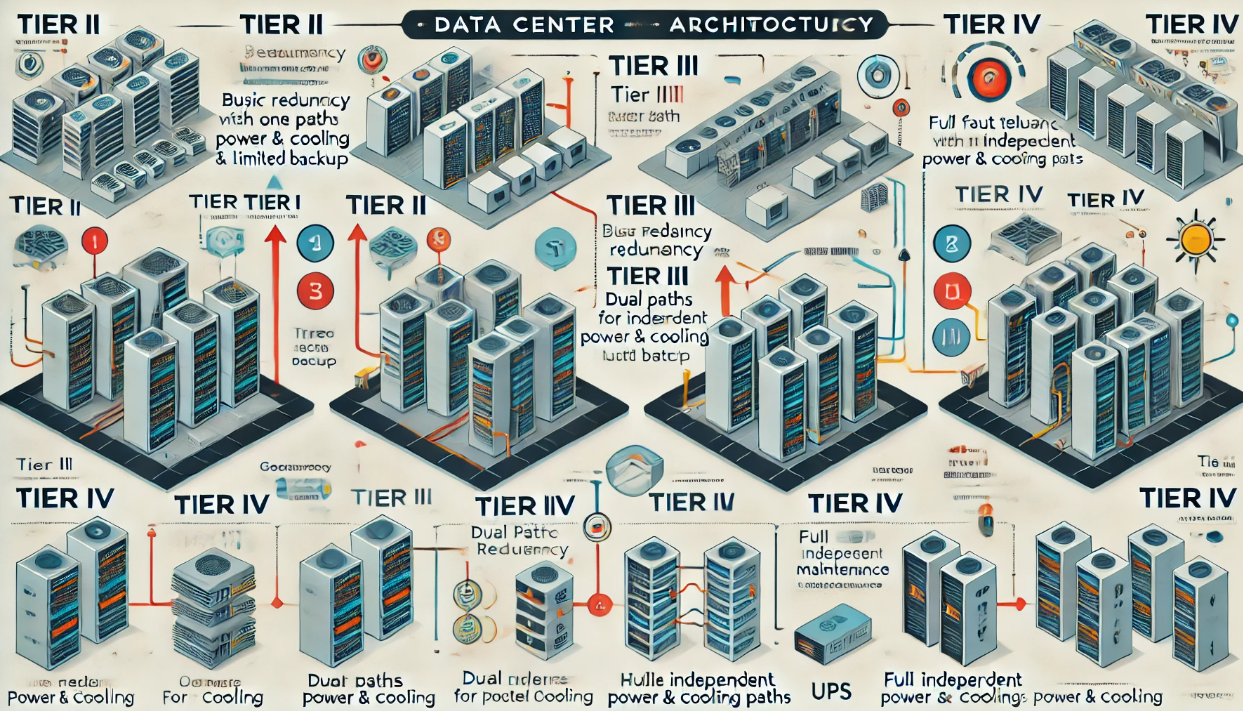Tier Levels in Data Centers: What Do Tier I, II, III, and IV Really Mean?
Meta Description: Confused about data center tiers? Discover what Tier I, II, III, and IV mean, and how they impact uptime, redundancy, reliability, and costs for your business-critical infrastructure.
Introduction: Not All Data Centers Are Created Equal
When choosing where to host your servers or colocate infrastructure, the data center’s tier level can make a massive difference.
But what do terms like Tier III or Tier IV actually mean?
Developed by the Uptime Institute, the data center tier classification system is an industry-standard way to rank data centers based on infrastructure reliability, redundancy, and uptime expectations.
Let’s break down Tier I through Tier IV, what each level offers, and which one is right for your needs.
Overview of Data Center Tiers
| Tier | Redundancy | Uptime SLA | Downtime/Year | Use Case |
|---|---|---|---|---|
| Tier I | No redundancy | ~99.671% | ~28.8 hours | Startups, dev/test |
| Tier II | Partial redundancy | ~99.741% | ~22 hours | Small businesses |
| Tier III | N+1 redundancy | ~99.982% | ~1.6 hours | Mid-to-large businesses |
| Tier IV | 2N+1 redundancy | ~99.995% | ~26.3 minutes | Enterprises, financial services |
Tier I Data Center – Basic Infrastructure
What It Offers:
-
Single path for power and cooling
-
No redundant components
-
No guarantee of backup during maintenance
Ideal For:
-
Small businesses
-
Testing environments
-
Low-priority applications
⚠️ Drawbacks:
-
No fault tolerance
-
Higher risk of downtime during maintenance or failure
Tier I is budget-friendly — but risky for mission-critical operations.
️ Tier II Data Center – Redundant Components
What It Offers:
-
Some redundancy (e.g., backup generators, cooling units)
-
Still a single path for power and data
-
Shorter downtime than Tier I
Ideal For:
-
Small-to-midsize companies
-
Customer-facing apps with moderate uptime requirements
⚠️ Drawbacks:
-
Still susceptible to maintenance-related outages
Tier II offers more reliability without a huge jump in cost.
Tier III Data Center – Concurrently Maintainable
What It Offers:
-
N+1 redundancy (one backup for every component)
-
Power and cooling delivered via multiple paths
-
Can perform maintenance without shutting down operations
Ideal For:
-
eCommerce platforms
-
SaaS apps
-
Growing businesses with SLA commitments
⭐ Key Benefit:
-
99.982% uptime = only 1.6 hours of downtime per year
Tier III is the sweet spot for most serious hosting environments.
Tier IV Data Center – Fault-Tolerant
What It Offers:
-
2N+1 redundancy (two active systems + backup)
-
Fully fault-tolerant — if one path fails, another takes over instantly
-
Physically isolated systems (dual power grids, cooling, etc.)
Ideal For:
-
Banks and financial institutions
-
Government and healthcare sectors
-
Enterprises with zero tolerance for downtime
⭐ Key Benefit:
-
Only 26.3 minutes of expected downtime/year
Tier IV is the gold standard for mission-critical, always-on operations.
Tier Level vs. Cost: What’s the Trade-Off?
As you go up the tier ladder:
-
Uptime improves
-
Redundancy increases
-
Costs rise (both for the data center and clients)
Ask yourself:
-
How much downtime can your business afford?
-
What are the financial and reputational costs of outages?
-
Does your SLA or compliance require a certain level of redundancy?
Don’t overpay for Tier IV if your business runs fine on Tier II — but don’t risk Tier I if uptime = revenue.
Final Thoughts: Choose a Tier That Matches Your Business Needs
Understanding data center tiers isn’t just technical trivia — it’s a strategic decision that impacts your:
-
Infrastructure resilience
-
Website/app availability
-
Customer trust
-
Compliance and risk management
Here’s the rule of thumb:
-
Tier I–II: Cost-effective for low-risk environments
-
Tier III: Best balance of price and performance
-
Tier IV: Ideal for operations where downtime = disaster
Choose wisely — and build on infrastructure that won’t let you down.

